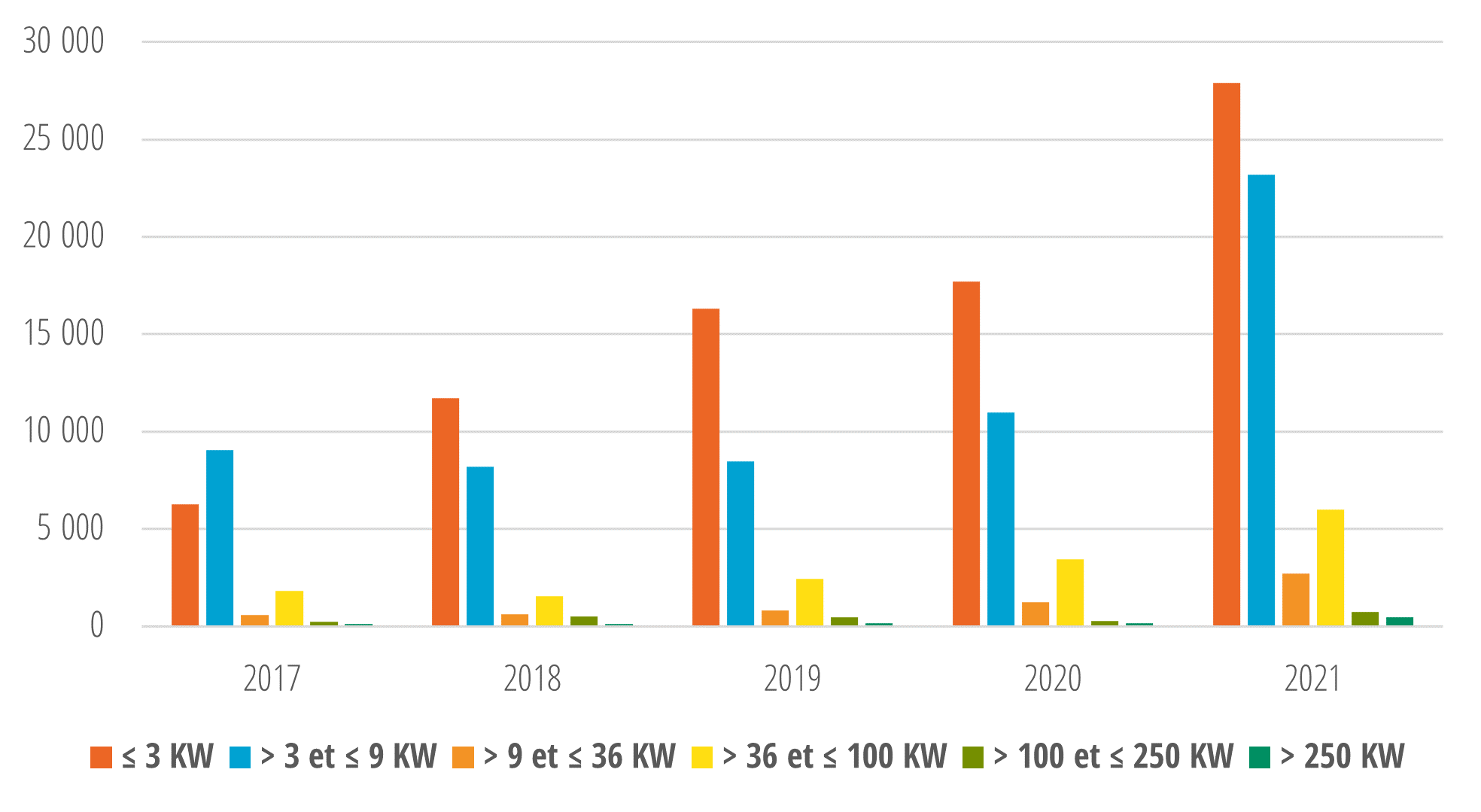Example of France in 2021
Get this executive brief in pdf format
With the European Green Deal1, Europe defined in 2020 a long-term strategy to achieve climate neutrality by 2050. This triggered the announcement of the REPowerEU plan2 in May 2022 with increased ambition of at least 45% of renewable energy by 2030. At the same time, came the announcement of European Solar Energy Strategy3 and a concrete objective of 320 GW of solar photovoltaic installations (cumulative) by 2025 and almost 600 GW by 2030.
The 2025 objective represents the double of existing installations as of 2020. Such ambitious objectives shall ramp-up the installation of solar energy.
Following these announcements, this brief will study what happened in 2021 in France and over Europe through overall figures analysed at fine scale.
Going through the latest statistics from the French ministry of sustainable development4, 2021 was a great year for photovoltaic (PV) in France: 61,000 installations or 2.8 GW installed, thus, compared to 2020, the number of units has been doubled, and the power capacity has been tripled.
These two figures break away from the annual growth trends since 2017.
This surge is due to various factors
- a "post-COVID" or "post world after effect" rebound,
- the urgency of matching the French “PPE” (long-term energy plan) targets,
- the reforms on the CRE4 and now PPE2 national utility calls for tenders,
- the evolution of PV panel prices: a historically low price of €0.22/Wp has been reached early 2021 (but with a +20% catch-up at the end of the year, linked to polysilicon supply issues)
- the evolution of wholesale gas and electricity prices, which have soared in 2021.
In terms of quantity, the number of installations was mainly driven by the small power installations: the categories “below 3kW” and “3 to 9kW” represented more than 75% of the installed volumes. These two categories have almost doubled in 2021 to more than 51,000 per year. Their annual growth was correct before (between 16 and 30%), but 2021 made a real breakthrough with +78%.
Figure 1: Number of installations in France (units)

Source: Enerdata, Data compilation from the French Ministry of Sustainable Development
This was not a "post-covid" recovery effect. The growth demonstrated a kind of “back in favour” for the PV since the moratorium at the end of 2010. We are witnessing a real change in the attitude of individuals. PV has regained prestige while feed-in tariffs continue to decline. The most likely reasons for individuals to produce their own electricity could be to anticipate the rise of electricity prices, or for resilience. This new trend grows despite the existence of a "price shield" from the French government against the rise in electricity and gas prices on the wholesale markets5, which we know may only be temporary.
If we reason in terms of power connected to the electricity grid, the pattern was reversed: it was not the residential sector that accounted for most of the 2.8 GW added in 2021 (it represented only about 200 MW, less than 10% of the total connected in MW). Most of the increase was made by the category of installations above 250 kW: 1.85 GW, equivalent to 66% of the 2.8 GW added.
Figure 2: PV connected to the grid in France (MW)

Source: Enerdata, Data compilation from the French Ministry of Sustainable Development
This dynamism can also be linked to the maximum limit of power plants, which was extended from 100 to 500 kW for the “open counter” (not subject to tenders such as “CRE call for tender”). But we can also notice the overall dynamism of all categories above 36 kW.
If this trend continues, from its 2021 capacity of 13.9 GW, France would be in a position by 2028 to reach the objective of 35 GW from the Multi-annual Energy Plan (MEAP or MEP). This target of cumulative installed capacity, corresponding to the worst-case scenario of the MEAP, was deemed unachievable by industry stakeholders before 2021. This means that CAGR (Cumulative Average Growth) would have to be at a minimum average of 14% per year between 2022 and 2028. Moreover, the government announced the target of 100 GW installed photovoltaic capacity in 2050 which we could add to the count.
Then, is France the world champion of PV?
Considering the 2021 European Market Outlook6 from Solar Power Europe, it turns out the record is European! According to the preliminary figures, the EU-27 would have installed nearly 26 GW in 2021, erasing the previous record from 2011 of 21.4 GW! Germany has installed 5 GW (close to 2020), Spain 4 GW, Netherlands and Poland slightly more than 3 GW, just ahead of France which is in 5th rank. Thus, it seems not be a Gallic specificity, but rather an underlying trend in Europe.
As a result, the ambitious goals defined in Europe’s REPowerEU plan are capitalising on this good trend initiated in 2021 and are spreading all over European members countries!
The future looks bright for solar in coming years in Europe and beyond.
Key take-aways: The current structural parameters making PV attractive
- The "grid parity", or difference between the price of electricity produced by a PV installation and the price of electricity drawn from the grid, is reached, or exceeded in France for medium to large installations (depending on the location and the type of installation).
- The panel price, which should return to the price level of early 2021 and even lower as soon as the polysilicon supply crisis is over.
- The increasing electrification of end applications (electric vehicles and heat pumps in particular)
If we add the current context of energy and electricity prices, and the geopolitical situation, this dynamic shall continue. But the French government will also have to do its homework and make more efforts to simplify the administrative process required and avoid scuttling the PV development as it was done in 2010 with the moratorium.
About the author
Fabrice POULIN
Clean Tech Team Manager at Enerdata

Fabrice joined Enerdata in 2021 together with the team of Infinergia that he founded in 2009.
He manages the “Clean Tech” team that executes market research, strategy consulting and techno-market due diligence.
He has over 25 years of experience of the industry & consulting. He has advised start-up, corporate, investors and research projects on multiple PV domains all along the value chain. He has a dual training in electronics and a marketing management degree from KEDGE Business School.
Notes:
- https://ec.europa.eu/info/strategy/priorities-2019-2024/european-green-…
- https://ec.europa.eu/info/strategy/priorities-2019-2024/european-green-…
- https://ec.europa.eu/info/law/better-regulation/have-your-say/initiativ…
- https://www.statistiques.developpement-durable.gouv.fr/publicationweb/4…
- https://www.lemonde.fr/politique/article/2021/09/30/flambee-des-tarifs-…
- solarpowereurope.org-insights-market-outlook
 Energy and Climate Databases
Energy and Climate Databases Market Analysis
Market Analysis